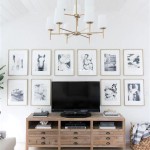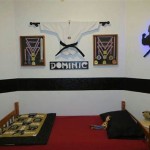```html
Dining Room Wallpaper Decor Ideas: Transforming the Heart of the Home
The dining room, often regarded as the heart of the home, serves as a gathering place for meals, celebrations, and cherished moments. The aesthetic of this space plays a significant role in setting the tone for these occasions, impacting both the ambiance and the overall dining experience. Wallpaper, a versatile and often overlooked design element, provides a powerful tool for transforming this space, allowing for the creation of unique and inviting environments. Careful selection and application of wallpaper can significantly elevate the dining room, reflecting personal style and adding depth and character.
Choosing the Right Wallpaper Style
The selection of wallpaper for a dining room should begin with careful consideration of the existing decor, lighting, and desired atmosphere. Options abound, ranging from subtle and sophisticated patterns to bold and dramatic designs. The chosen style should complement the furniture, flooring, and overall architectural features of the room. Neutral shades, such as soft creams, grays, or beiges, offer a timeless elegance and provide a versatile backdrop that works well with a variety of furniture styles. These colors also create a sense of spaciousness, making them an excellent choice for smaller dining rooms. Incorporating texture, even within a neutral palette, can add depth without overpowering the space. Textured wallpapers can emulate the look of linen, silk, or even stone, adding a touch of luxury and visual interest.
For those seeking to make a bold statement, patterned wallpapers offer a myriad of possibilities. Consider the scale and intricacy of the pattern in relation to the size of the room. Larger, more elaborate patterns can be used effectively in spacious dining rooms, creating a focal point and adding a sense of grandeur. Smaller patterns, such as geometric designs, floral motifs, or damask prints, can be equally effective in smaller spaces, adding visual interest without overwhelming the room. Color plays a crucial role in the impact of patterned wallpaper. Cool hues, such as blues and greens, often create a calming and serene environment, while warmer tones, such as reds and oranges, can stimulate appetite and add a sense of vibrancy. Consider the lighting in the room; wallpaper with metallic accents or reflective finishes can enhance the brightness and create a more luxurious feel, especially in rooms with limited natural light.
Considering Color and Pattern Harmony
Color is a critical element in wallpaper selection, as it directly influences the mood of the room. Before selecting a wallpaper, it is beneficial to consider the existing color scheme of the dining room, including the furniture, flooring, and any existing artwork. If the room has a lot of neutral elements, a patterned wallpaper with a bold color palette might be a welcome addition, adding a pop of interest. Conversely, if the room already has a strong color palette, a more muted wallpaper may be the more appropriate choice. It is also important to consider the specific color's impact on the dining experience. For example, some research suggests that warm colors like red and orange can stimulate appetite, while cooler colors like blue and green create a more relaxing atmosphere. The direction the room faces also has an impact on color. For example, a room that gets a lot of direct sunlight may be able to handle more intense colors without looking overwhelming.
Pattern selection is another crucial consideration. The size and scale of the pattern should be considered in relation to the room’s dimensions. Small, repetitive patterns can make a room appear larger, while bold, oversized patterns can make a room appear smaller and more intimate. Geometric patterns, such as stripes, chevrons, and trellis designs, offer a contemporary and modern aesthetic. Floral and botanical patterns evoke a sense of nature and tranquility. Traditional patterns, such as damask, toile, and chinoiserie, can add a touch of elegance and history to the space. Consider also the wallpaper's impact on the room's overall style. Does the goal create a room that feels traditional, modern, or something in between? The choice of pattern should reflect this overall goal for the space.
Wallpaper Material and Durability Considerations
Wallpaper materials vary, and the choice should align with the needs of the dining room environment. Vinyl wallpapers are particularly well-suited for dining rooms, as they are durable, moisture-resistant, and easy to clean. This is especially beneficial in dining areas where spills and splatters are common. Vinyl wallpapers can be particularly useful behind the dining table or in areas near serving stations. Paper wallpapers offer a more traditional and elegant look, but they are less durable and more susceptible to damage from moisture. Non-woven wallpapers are an increasingly popular option. These are often easier to install and remove than traditional wallpaper, making them a good choice for those who frequently want to change their decor. They also have good breathability and resistance to tearing. The longevity and cleanability of the wallpaper should be considered when selecting a wallpaper.
Strategic Application Techniques
Where and how wallpaper is applied is important. Covering all four walls with wallpaper can create a dramatic and immersive effect, especially when using a bold pattern or color. However, in smaller dining rooms, this may make the space feel enclosed. An alternative approach is to use wallpaper as an accent wall. This involves applying wallpaper to a single wall, such as the wall behind the dining table or a fireplace, to create a focal point and add visual interest. This can be particularly effective when using a patterned wallpaper, allowing the pattern to shine without overwhelming the entire room. Another strategic technique is to wallpaper the upper portion of the walls, pairing it with a chair rail or wainscoting on the lower portion. This approach creates visual interest and adds architectural detail, while providing a durable and easily cleanable surface on the lower portion of the walls.
Beyond wall application, wallpaper can be used in other creative ways, such as on the ceiling or inside of built-in cabinetry. Painting the ceiling with wallpaper can make a room feel more interesting, especially if it has a unique pattern or texture. Using wallpaper inside of cabinets or on shelves can add a pop of color and personality to the room. This approach can be especially effective when using patterned wallpaper with a color scheme that complements the rest of the room's decor.
```
18 Dining Room Wallpaper Ideas That Ll Elevate All Your Dinner Parties
:strip_icc()/127107347_378909933559802_5209338986625741338_n-d8e04eccf7274b2b91e5b75ec9ca40ef.jpg?strip=all)
29 Dining Room Wall Décor Ideas

12 Stunning Modern Dining Room Wall Decor Ideas Design Cafe

58 Dining Room Wallpaper Ideas Splendid Colorful
:max_bytes(150000):strip_icc()/art4-445991107c1841ccb4f3a266e6793183.jpg?strip=all)
46 Dining Room Wall Art Ideas For Elevated Entertaining
:strip_icc()/ReenaSotropaDesign-38417faac3dc49ac88c25cbe42c860da.jpg?strip=all)
20 Dining Room Wallpaper Ideas We Love

27 Splendid Wallpaper Decorating Ideas For The Dining Room

Dining Room Wallpaper Ideas Trends

165 Modern Dining Room Design And Decorating Ideas Accents Contemporary

20 Ways To Dress Up Dining Room Walls Wall Decor







